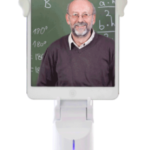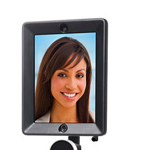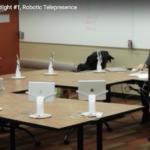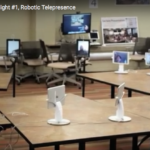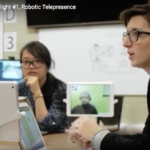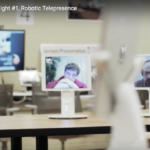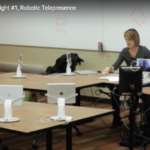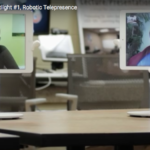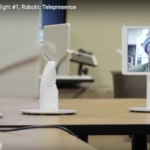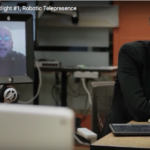Blended Online Learning Design
Michigan State University uses robotic telepresence to transform the online students’ experience
Typically in a video-based blended online course, students attending virtually are displayed on a screen at the rear of the classroom. Without proper pedagogy, instructors cannot engage the online students nor encourage interaction with the students who are physically present.
The design studio at Michigan State University School of Education took an innovative approach to blended learning. Michigan State virtual students now have control of their presence in the classroom environment. They are no longer relegated to the screen hanging on the wall. Instead, they sit among those physically present, just as if they were on campus.
Some online students are present on roll-about robots called ‘The Double.’ Others are on desktop robots called the ‘Kubi.’ Online students join the class by video conference. They log in and take control of the robot. By doing so they can control where they sit and what they see. Being among the students changes the entire dynamic of the learning environment. Michigan State calls it “Discernible Attention.”
Faculty member Christine Greenhow from the School of Education shares her experience: “Those of us on campus, we felt our colleagues were physically present and for the online students they felt that they were in this class. We had several students tweet out ‘best class ever’ or ‘you’re breaking new ground in educational technology,’ ‘try new things in EPET and that’s really terrific because you are supposed to be about pushing the boundaries of educational technology and here we really are breaking new ground and the students love that”
Robotic telepresence is being used outside the class for team meetings and small groups as well. Michigan State University has done a great job in making the distance disappear to fully engage all students in a hybrid or blended classroom.
Dr. John Bell, Director of the Design Studio at Michigan State University’s School of Education, takes a scholarly approach to research in the field of online learning. With most students focused in education and educational technology, the Design Studio offers the perfect test bed for innovative approaches for online learning.
Moving forward in online and blended learning
In the past, most universities have offered traditional courses and blended in online students. The staff would work to make sure the addition of online didn’t disrupt learning. Consequently, students felt like outsiders who must ask permission to participate.
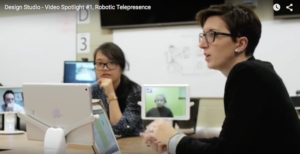 Now, the Design Studio is pushing against the norm by making sure the online component doesn’t diminish the learning experience for all students. As such, they have set a high bar of mutualism with a goal to make online students feel like contributors when blended into a traditional face-to-face classroom. They want to make the experience better for all students by engaging online students so they feel like insiders and traditional students then feel that they greatly benefit from what online students bring to the blended learning experience.
Now, the Design Studio is pushing against the norm by making sure the online component doesn’t diminish the learning experience for all students. As such, they have set a high bar of mutualism with a goal to make online students feel like contributors when blended into a traditional face-to-face classroom. They want to make the experience better for all students by engaging online students so they feel like insiders and traditional students then feel that they greatly benefit from what online students bring to the blended learning experience.
Video conferencing and robotic telepresence
A unique approach has been implemented to break down transactional distance by having online students be virtually present through video conferencing on robots. Students login and take control of an available desktop or cart/Segway style robot. Their faces appear on the robot display. The robot takes a space at the “table” as if the student was physically present in class. Michigan State University (MSU) selected desktop and rollabout robots from companies including Kubi from Revolve Robotics, Beam from Suitable Technologies, and Double from Double Robotics. Video conferencing tools including GotoMeeting, Zoom and Polycom are used to connect.
In this new environment, students felt as if they were all physically present together in this blended learning environment. They are able to interact and have group discussions as well as side conversations as if they are all actually in the room. Instructors could look across the classroom and ascertain the level of engagement of all students, both online and those physically in the room. This new level of social presence enabled instructors to view body language, detect confusion, frustration, or excitement and respond. A new phrase has been given to describe this phenomenon. MSU calls it “discernable attention.”
Hybrid Learning Study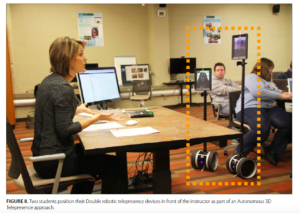
MSU conducted a comparison study focused on this new hybrid learning approach. The CEPSE/COE Design Studio is an in-house resource for the research, design, and support of technology-mediated learning contexts. With the significant role it plays regarding the challenges of implementing rich synchronous, they were able to address and learn from the new hybrid learning environments.
The study, reported in The International Journal of Designs for Learning describes their impetus for the new innovations, the innovations themselves, and the good and bad lessons learned. With a goal to enable a comparable sense of social presence to both our on-campus and hybrid students, many things were tried. They experienced many failures and realized much success.
With the introduction of the robotic telepresence devices, the online students reported a significant shift in their thinking. By being present via a robot, they felt as if they were physically present in the classroom rather than observing from afar.
Having accessibility to move about the campus or classroom even when not present allows great flexibility for a flipped classroom, lecture, or any preferred pedagogical style of delivery.

